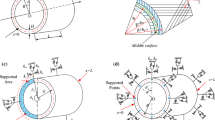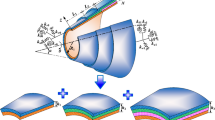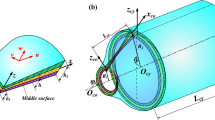Abstract
In this paper, a new and an efficient solution method based on local gradient smoothing method has been applied to free vibration problem of open composite laminated cylindrical and conical shells with elastic boundary conditions. The theoretical model is formulated by the first-order shear deformation theory, and the motion equation is obtained by the Hamilton’s principle. The motion equation is discretized by meshless shape function; in this process, the derivatives of the shape function are approximated by local gradient smoothing method. The accuracy, applicability and efficiency of this method are demonstrated for free vibrations of open composite laminated cylindrical and conical shells with different geometric, material parameters and boundary condition. The numerical results show good convergence characteristics and good agreement between the present method and the existing literature. And through several numerical examples, some useful results for free vibration results of open composite laminated cylindrical and conical shells are obtained, which may serve as a benchmark solutions for researchers to check their analytical and numerical methods.











Similar content being viewed by others
Data Availability Statement
This manuscript has associated data in a data repository. [Authors’ comment: All data included in this manuscript are available upon request by contacting with the corresponding author.]
References
A.W. Leissa, R.P. Nordgren, Vibration of Shells (NASA SP-288) (US: Government Printing Office, Washington, 1973)
C. Shu, Free vibration analysis of composite laminated conical shells by generalized differential quadrature. J. Sound Vib. 194(4), 587–604 (1996)
L. Hua, Frequency characteristics of a rotating truncated circular layered conical shell. Compos. Struct. 50(1), 59–68 (2000)
Y. Ng, L. Hua, K.Y. Lam, Generalized differential quadrature for free vibration of rotating composite laminated conical shell with various boundary conditions. Int. J. Mech. Sci. 45(3), 567–587 (2003)
Ö. Civalek, Numerical analysis of free vibrations of laminated composite conical and cylindrical shells. J. Comput. Appl. Math. 205(1), 251–271 (2007)
Ö. Civalek, Vibration analysis of laminated composite conical shells by the method of discrete singular convolution based on the shear deformation theory. Compos. B Eng. 45(1), 1001–1009 (2013)
Y. Qu, X. Long, S. Wu, G. Meng, A unified formulation for vibration analysis of composite laminated shells of revolution including shear deformation and rotary inertia. Compos. Struct. 98, 169–191 (2013)
K.K. Viswanathan, J.H. Lee, Z.A. Aziz, I. Hossain, R. Wang, H.Y. Abdullah, Vibration analysis of cross-ply laminated truncated conical shells using a spline method. J. Eng. Math. 76, 139–156 (2012)
C. Wu, C. Lee, Differential quadrature solution for the free vibration analysis of laminated conical shells with variable stiffness. Int. J. Mech. Sci. 43(8), 1853–1869 (2001)
I.F.P. Correia, C.M.M. Soares, C.A.M. Soares, J. Herskovits, Analysis of laminated conical shell structures using higher order models. Compos. Struct. 62(3–4), 383–390 (2003)
J.N. Reddy, C.F. Liu, A higher-order shear deformation theory of laminated elastic shells. Int. J. Eng. Sci. 23(3), 319–330 (1985)
A.J.M. Ferreira, C.M.C. Roque, R.M.N. Jorge, Modelling cross-ply laminated elastic shells by a higher-order theory and multiquadrics. Comput. Struct. 84(19–20), 1288–1299 (2006)
A.J.M. Ferreira, C.M.C. Roque, R.M.N. Jorge, Static and free vibration analysis of composite shells by radial basis functions. Eng. Anal. Bound. Elem. 30(9), 719–733 (2006)
M. Ganapathi, B.P. Patel, D.S. Pawargi, Dynamic analysis of laminated cross-ply composite non-circular thick cylindrical shells using higher-order theory. Int. J. Solids Struct. 39(24), 5945–5962 (2002)
B. Damjan, M. Bacciocchi, F. Tornabene, Influence of Winkler–Pasternak foundation on the vibrational behavior of plates and shells reinforced by agglomerated carbon nanotubes. Appl. Sci. 7(12), 1–55 (2017)
F. Tornabene, Free vibrations of anisotropic doubly-curved shells and panels of revolution with a free-form meridian resting on Winkler–Pasternak elastic foundations. Compos. Struct. 94(1), 186–206 (2011)
F. Tornabene, A. Ceruti, Free-form laminated doubly-curved shells and panels of revolution resting on Winkler–Pasternak elastic foundations: a 2-D GDQ solution for static and free vibration analysis. World J. Mech. 3(1), 1–25 (2013)
F. Tornabene, J. Reddy, FGM and laminated doubly-curved and degenerate shells resting on nonlinear elastic foundations: a GDQ solution for static analysis with a posteriori stress and strain recovery. J. Indian Inst. Sci. 93(4), 635–688 (2013)
F. Tornabene, N. Fantuzzi, E. Viola, J.N. Reddy, Winkler-Pasternak foundation effect on the static and dynamic analyses of laminated doubly-curved and degenerate shells and panels. Compos. B Eng. 57, 269–296 (2014)
B. Qin, R. Zhong, T. Wang, Q. Wang, Y. Xue, Z. Hu, A unified Fourier series solution for vibration analysis of FG-CNTRC cylindrical, conical shells and annular plates with arbitrary boundary conditions. Compos. Struct. 232(15), 111549 (2020)
H. Zhang, D. Shi, Q. Wang, An improved Fourier series solution for free vibration analysis of the moderately thick laminated composite rectangular plate with non-uniform boundary conditions. Int. J. Mech. Sci. 121, 1–20 (2017)
H. Zhang, H. Hong, D. Shi, S. Zha, Q.Wang, A modified Fourier solution for sound-vibration analysis for composite laminated thin sector platecavity coupled system. Compos. Struct. 207, 560–575 (2019)
D. Shi, G. Liu, H. Zhang, W. Ren, Q. Wang, A three-dimensional modeling method for the trapezoidal cavity and multi-coupled cavity with various impedance boundary conditions. Appl. Acoust. 154, 213–225 (2019)
G. Jin, T. Ye, Y. Chen, Z. Su, Y. Yan, An exact solution for the free vibration analysis of laminated composite cylindrical shells with general elastic boundary conditions. Compos. Struct. 106(12), 114–127 (2013)
G. Jin, T. Ye, X. Ma, Y. Chen, Z. Su, X. Xie, A unified approach for the vibration analysis of moderately thick composite laminated cylindrical shells with arbitrary boundary conditions. Int. J. Mech. Sci. 75(10), 357–376 (2013)
J. Zhao, K. Choe, C. Shuai, A. Wang, Q. Wang, Free vibration analysis of functionally graded carbon nanotube reinforced composite truncated conical panels with general boundary conditions. Compos. B Eng. 160(1), 225–240 (2019)
K. Choe, K. Kim, Q. Wang, Dynamic analysis of composite laminated doubly-curved revolution shell based on higher order shear deformation theory. Compos. Struct. 225(1), 111155 (2019)
B. Qin, K. Choe, Q. Wu, T. Wang, Q. Wang, A unified modeling method for free vibration of open and closed functionally graded cylindrical shell and solid structures. Compos. Struct. 223(1), 110941 (2019)
B. Qin, K. Choe, T. Wang, Q. Wang, A unified Jacobi–Ritz formulation for vibration analysis of the stepped coupled structures of doubly-curved shell. Compos. Struct. 220, 717–735 (2019)
J. Zhao, K. Choe, C. Shuai, A. Wang, Q. Wang, Free vibration analysis of laminated composite elliptic cylinders with general boundary conditions. Compos. B Eng. 158, 55–66 (2019)
K. Choe, Q. Wang, J. Tang, C. Shuai, Vibration analysis for coupled composite laminated axis-symmetric doubly-curved revolution shell structures by unified Jacobi–Ritz method. Compos. Struct. 194, 136–157 (2018)
H. Haftchenari, M. Darvizeh, A. Darvizeh, R. Ansari, C.B. Sharma, Dynamic analysis of composite cylindrical shells using differential quadrature method (DQM). Compos. Struct. 78(2), 292–298 (2007)
F. Tornabene, N. Fantuzzi, M. Bacciocchi, J.N. Reddy, A posteriori stress and strain recovery procedure for the static analysis of laminated shells resting on nonlinear elastic foundation. Compos. B Eng. 126, 162–191 (2017)
Y. Qu, H. Hua, G. Meng, A domain decomposition approach for vibration analysis of isotropic and composite cylindrical shells with arbitrary boundaries. Compos. Struct. 95, 307–321 (2013)
X. Xie, G. Jin, W. Li, Z. Liu, A numerical solution for vibration analysis of composite laminated conical, cylindrical shell and annular plate structures. Compos. Struct. 111, 20–30 (2014)
R. Talebitooti, V.S. Anbardan, Haar wavelet discretization approach for frequency analysis of the functionally graded generally doubly-curved shells of revolution. Appl. Math. Model. 67, 645–675 (2019)
X. Zhao, K.M. Liew, T.Y. Ng, Vibration analysis of laminated composite cylindrical panels via a meshfree approach. Int. J. Solids Struct. 40(1), 161–180 (2003)
K.M. Liew, X. Zhao, A.J.M. Ferreira, A review of meshless methods for laminated and functionally graded plates and shells. Compos. Struct. 93(8), 2031–2041 (2011)
H. Assaee, H. Hasani, Forced vibration analysis of composite cylindrical shells using spline finite strip method. Thin-Walled Struct. 97, 207–214 (2015)
N.S. Bardell, R.S. Langley, J.M. Dunsdon, G.S. Aglietti, An h-p finite element vibration analysis of open conical sandwich panels and conical sandwich frusta. J. Sound Vib. 226(2), 345–377 (1999)
G.R. Liu, Y.T. Gu, An Introduction to Meshfree Methods and Their Programming (Springer, Dordrecht, 2005)
B. Chinnaboon, S. Chucheepsakul, J.T. Katsikadelis, A BEM-based domain meshless method for the analysis of Mindlin plates with general boundary conditions. Comput. Methods Appl. Mech. Eng. 200(13–16), 1379–1388 (2011)
J. Sorić, T. Jarak, Mixed meshless formulation for analysis of shell-like structures. Comput. Methods Appl. Mech. Eng. 199(17–20), 1153–1164 (2010)
W. Li, Z.X. Gong, Y.B. Chai, C. Cheng, T.Y. Li, Q.F. Zhang, M.S. Wang, Hybrid gradient smoothing technique with discrete shear gap method for shell structures. Comput. Math Appl. 74(8), 1826–1855 (2017)
M.R. Moghaddam, G.H. Baradaran, Three-dimensional free vibrations analysis of functionally graded rectangular plates by the meshless local PetrovGalerkin (MLPG) method. Appl. Math. Comput. 304, 153–163 (2017)
E. Shivanian, Meshless local Petrov–Galerkin (MLPG) method for three-dimensional nonlinear wave equations via moving least squares approximation. Eng. Anal. Bound. Elem. 50, 249–257 (2015)
P.H. Wen, Meshless local Petrov–Galerkin (MLPG) method for wave propagation in 3D poroelastic solids. Eng. Anal. Bound. Elem. 34(4), 315–323 (2010)
I. Alfaro, J. Yvonnet, E. Cueto, F. Chinesta, M. Doblare, Meshless methods with application to metal forming. Comput. Methods Appl. Mech. Eng. 195(48–49), 6661–6675 (2006)
Z. Mao, G.R. Liu, A Lagrangian gradient smoothing method (L-GSM) for solid-flow problems using simplicial mesh. Int. J. Numer. Methods Eng. 113, 858–890 (2017)
D. Hui, G.Y. Zhang, D.P. Yu, Z. Sun, Z. Zong, Numerical study of advection schemes for interface-capturing using gradient smoothing method. Numer. Heat Transf. B Fundam. 73(4), 242–261 (2018)
J. Yao, G.R. Liu, D. Qian, C. Chen, G.X. Xu, A moving-mesh gradient smoothing method for compressible CFD problems. Math. Models Methods Appl. Sci. 23(02), 273–305 (2013)
E. Li, V. Tan, G.X. Xu, G.R. Liu, Z.C. He, A novel alpha gradient smoothing method (αGSM) for fluid problems. Numer. Heat Transf. B Fundam. 61(3), 204–228 (2012)
B. Shao, G.R. Liu, T. Lin, G.X. Xu, X. Yan, Rotation and orientation of irregular particles in viscous fluids using the gradient smoothed method (GSM). Eng. Appl. Comput. Fluid Mech. 11(1), 557–575 (2017)
G.X. Xu, G.R. Liu, A. Tani, An adaptive gradient smoothing method (GSM) for fluid dynamics problems. Int. J. Numer. Methods Fluids 62(5), 499–529 (2009)
Z. Han, H.T. Liu, A. Rajendran, S.N. Atluri, The applications of meshless local Petrov–Galerkin (MLPG) approaches in high-speed impact, penetration and perforation problems. Comput. Model. Eng. Sci. 14(2), 119–128 (2006)
G.R. Liu, An overview on meshfree methods: for computational solid mechanics. Int. J. Comput. Methods 13(05), 1630001 (2016)
S. Daxini, J. Prajapati, A review on recent contribution of meshfree methods to structure and fracture mechanics applications. Sci. World J. 1, 1–13 (2014)
J. Zhang, G.R. Liu, K.Y. Lam, H. Li, G. Xu, A gradient smoothing method (GSM) based on strong form governing equation for adaptive analysis of solid mechanics problems. Finite Elem. Anal. Des. 44(15), 889–909 (2008)
G.R. Liu, B.B.T. Kee, L. Chun, A stabilized least-squares radial point collocation method (LS-RPCM) for adaptive analysis. Comput. Methods Appl. Mech. Eng. 195(37–40), 4843–4861 (2006)
F. Auricchio, L.B. Da Veiga, T.J.R. Hughes, A. Reali, G. Sangalli, Isogeometric collocation methods. Math. Models Methods Appl. Sci. 20(11), 2075–2107 (2010)
E. Oñate, F. Perazzo, J. Miquel, A finite point method for elasticity problems. Comput. Struct. 79(22–25), 2151–2163 (2001)
A. Karamanli, A. Mugan, Strong form meshless implementation of Taylor series method. Appl. Math. Comput. 219(17), 9069–9080 (2013)
D.D. Wang, J.C. Wu, An efficient nesting sub-domain gradient smoothing integration algorithm with quadratic exactness for Galerkin meshfree methods. Comput. Methods Appl. Mech. Eng. 298, 485–519 (2016)
G.R. Liu, J. Zhang, K.Y. Lam, H. Li, G. Xu, Z.H. Zhong, G.Y. Li, X. Han, A gradient smoothing method (GSM) with directional correction for solid mechanics problems. Comput. Mech. 41(3), 457–472 (2008)
M.S. Qatu, Vibration of Laminated Shells and Plates (Elsevier, San Diego, 2004)
T. Ye, G. Jin, Z. Su, X. Jia, A unified Chebyshev-Ritz formulation for vibration analysis of composite laminated deep open shells with arbitrary boundary conditions. Arch. Appl. Mech. 84(4), 441–471 (2014)
Author information
Authors and Affiliations
Corresponding author
Appendix
Appendix
Detailed expressions of differential operators \( L_{ij} \):
Rights and permissions
About this article
Cite this article
Kwak, S., Kim, K., Ri, Y. et al. Natural frequency calculation of open laminated conical and cylindrical shells by a meshless method. Eur. Phys. J. Plus 135, 434 (2020). https://doi.org/10.1140/epjp/s13360-020-00438-0
Received:
Accepted:
Published:
DOI: https://doi.org/10.1140/epjp/s13360-020-00438-0




